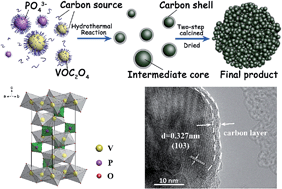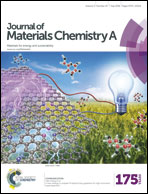A new anode material for high performance lithium-ion batteries: V2(PO4)O/C†
Abstract
V2(PO4)O/C is a promising new anode material for lithium ion batteries with excellent electrochemical properties, synthesized by a facile one pot hydrothermal method, followed by a two-step calcination process. The composite can deliver a reversible capacity of 445 mA h g−1, 409 mA h g−1 and 382 mA h g−1 at 1.0, 1.5 and 2.0 A g−1. The capacity retentions of V2(PO4)O/C cycled at 1 and 5 A g−1 for 200 cycles are 90% and 80%, respectively. The excellent electrochemical properties are mainly attributed to the following three factors: (1) face-sharing [VO6] octahedral arrays endow the crystal with a high intrinsic electronic conductivity; (2) the good lithium ion diffusion coefficient of the material contributes for reducing electrochemical and concentration polarization in the charge–discharge process; and (3) porous microstructure and nanoscale particles not only permit effective contact between the electrolyte and active material, but also provide more space to accommodate volume change during the discharge/charge processes. The results in this study provide convincing evidence that V2(PO4)O/C has significant research value for future practical applications.


 Please wait while we load your content...
Please wait while we load your content...